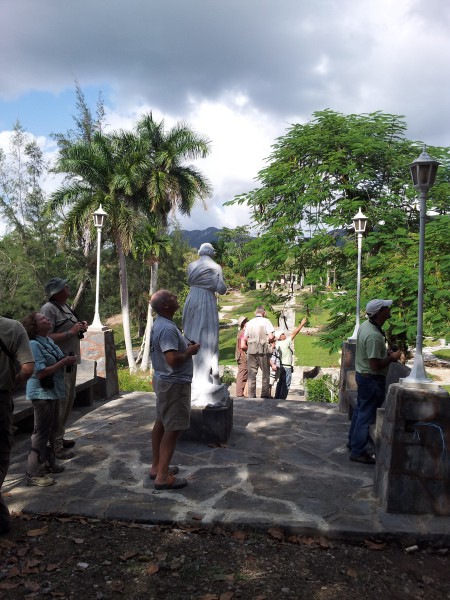Ohio Ornithological Society Cuba Bird Survey
February 20 – March 3, 2017
Cuba’s Western Mountains, Zapata Swamp, Atlantic Archipelago, Eastern Endemic Range and Colonial Havana
The Ohio Ornithological Society (OOS) is promoting an exclusive, U.S. led and managed birding program to Cuba! The program is managed by the Caribbean Conservation Trust, Inc. (CCT), which is based in Connecticut. In early 2016 CCT staff began their 20th year of managing bird conservation and natural history programs in Cuba. Along with OOS leader Randy Rogers, our team will include one of CCT’s talented full time Cuban naturalists, a bilingual Cuban tour leader and local naturalists in 4 different birding regions. They will guide you through some of the best birding habitat in Cuba, the Caribbean’s largest and most ecologically diverse island nation.
Our Cuba Bird Survey begins and ends in Havana, one of the most authentic colonial cities in the Americas. We will arrive in Havana from Miami and depart for Cuba’s rural provinces and magnificent birding areas. Upon our return to Havana at the end of the birding program, we will spend 2 nights in Havana, one of Latin America’s best preserved and most compelling colonial cities. Here we will visit Ernest Hemingway’s former home at Finca Vigia, as well as other sites within Habana Vieja (Old Havana) declared a UNESCO World Heritage site in 1987. Old Havana is like a living museum, and is currently undergoing rapid, energetic change. Our time there will also include an interpretive tour of the city’s 4 historic plazas, dating back to the 16th century.
CCT designed this itinerary to take you to Cuba’s finest bird habitats, most beautiful national parks, diverse biosphere reserves, and unique natural areas. We will interact with local scientists and naturalists who work in research and conservation. In addition to birding, we will learn about the ecology and history of regions we visit. Finally, we can expect some degree of indulgence in the richness of Cuban culture, architecture, and history.



Where We Travel
Our Cuba Bird Survey begins and ends in Havana, with an evening in a comfortable hotel in a quiet residential part of the city. We return to Havana at the end of the birding program, spending an afternoon and evening as described below.
Cuba’s Western Mountains
Cuba’s Western Mountains include two of the country’s most diverse and dramatic ranges: the Sierra de la Rosario, and Sierra de los Organos. We will explore an area common to both ranges in search of western range endemic species such as the Cuban Solitaire. A highlight of the trip, we will visit the magical, unusually beautiful karstic landscape of mogotes– the towering, lushly vegetated, flat-top limestone monoliths that dominate the Organos Mountains. This is the only region in which we will likely see the Cuban Solitaire, Cuban Grassquit, Giant Kingbird, & Olive-capped Warbler. Other potential endemic species for western Cuba include Cuban Oriole, Cuban Blackbird, Cuban Green Woodpecker, Cuban Pewee, Cuban Pygmy-Owl, Cuban Tody, Cuban Trogon, Cuban Vireo, & Yellow–headed Warbler. (2 nights)
Zapata Peninsula - Bay of Pigs
We will also explore the diverse wetland region of the Zapata Peninsula, Cuba’s richest and most importantbirding destination located in the historic Bay of Pigs. This peninsula is a Ramsar Convention (international conservation treaty) designated site, and is among the most important wetlands in the West Indies. Here, the best local guides will lead us through protected areas in Cienaga de Zapata National Park and other natural sites off the beaten track. The Zapata Peninsula covers more than 2800 square miles and features easily accessible, everglades-like ecology and habitat. Framed by the pristine Caribbean coastal environment of the Bay of Pigs, the peninsula features vast open swamp land, low coastal forests, sparkling white sand beaches, healthy and accessible coral reefs, and refreshing natural limestone pools called cenotes. Bee Hummingbird, Cuban Black Hawk, Zapata Wren, Zapata Sparrow, Fernandina’s Flicker, Bare-legged Owl, Tawny- shouldered and Blue-headed and Grey-fronted Quail Doves, Red-shouldered Blackbird are among the many birds we will hope to find (3 nights).
Cayo Coco and Cuba’s Atlantic Archipelago
Cayo Coco and Cuba’s Atlantic Archipelago provides excellent birding opportunities on Cuba’s Atlantic coast. These previously uninhabited and relatively unexplored offshore islands were connected to the mainland by an 18 mile causeway completed in 1989. Cuba’s academy of sciences (CITMA) maintains a research facility here. These barrier islands provide unique opportunities for: Cuban Gnatcatcher, Oriente Warbler, Thick-billed Vireo, Bahama Mockingbird, West Indian Whistling Duck, as well as numerous shorebirds and aquatic birds. This region provides additional opportunities to see rare endemics such as Zapata Sparrow & Gundlach’s Hawk. Accommodations are in a modern beachfront resort (2 nights).
Havana
Our Cuba Bird Survey begins and ends in Havana, one of the most authentic colonial cities in the Americas. We will arrive in Havana from Miami and depart for Cuba’s rural provinces and magnificent birding areas. Upon our return to Havana at the end of the birding program, we will spend 2 nights in Havana, one of Latin America’s best preserved and most compelling colonial cities.
